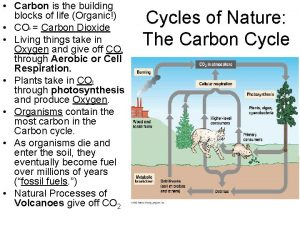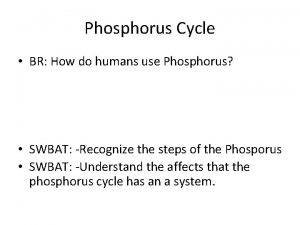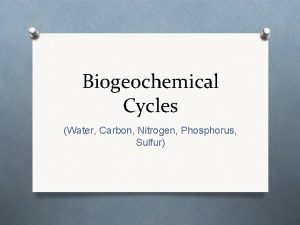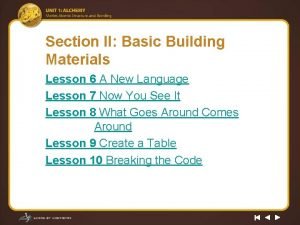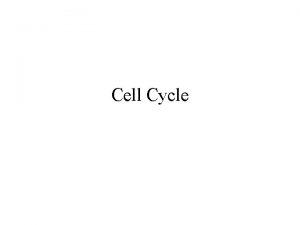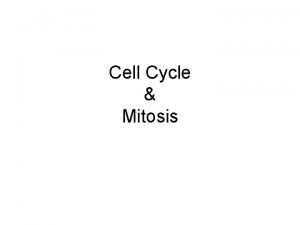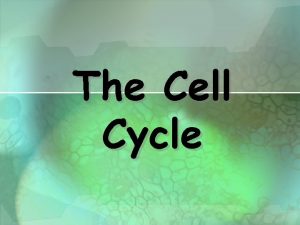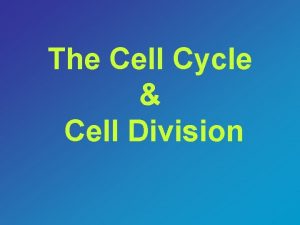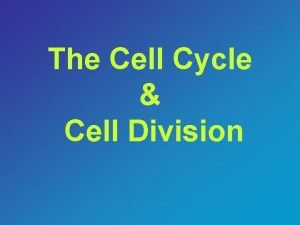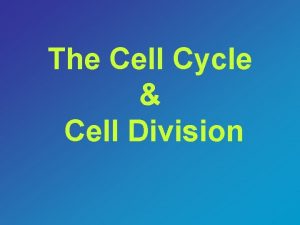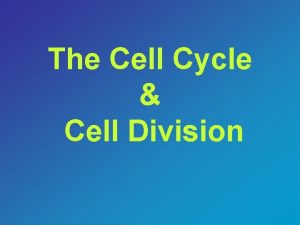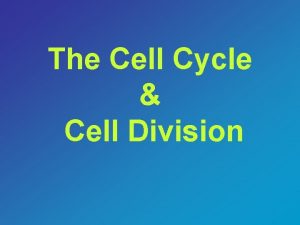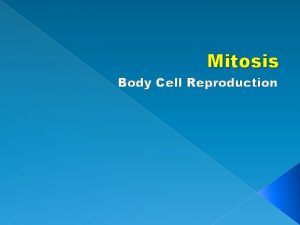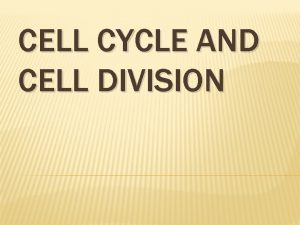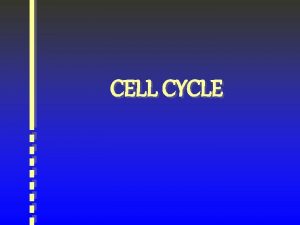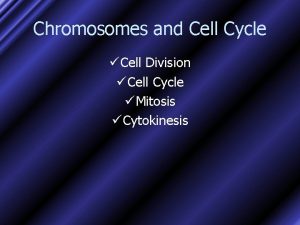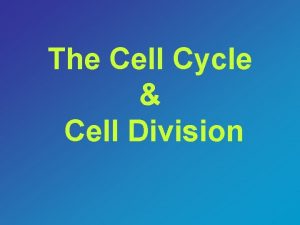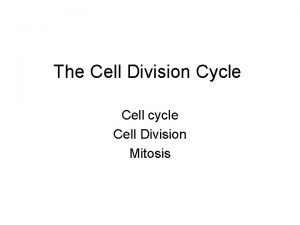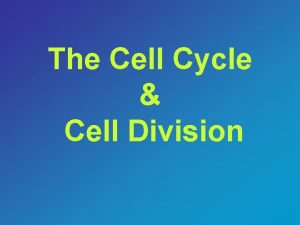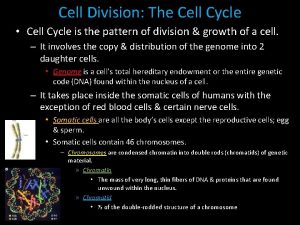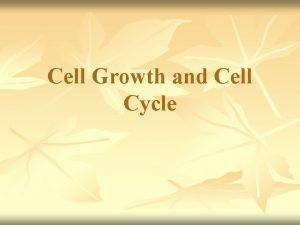The Cell Cycle Do Now 1220 Are humans









































- Slides: 41

The Cell Cycle

Do Now 12/20 Are humans able to regenerate cells?

Our knowledge of cancer focuses on how cells divide… MITOSIS!

Why do Cells Divide? § Single-celled organisms u amoeba Asexual reproduction § Multi-celled organisms Growth & development u Repair & replacement u starfish

Mitosis • Type of cell division when 1 cell divides into 2 new daughter cells • Each daughter cell has identical DNA to the parent cell


What is DNA? Genetic information located on chromosomes in the nucleus that determine traits

Structure of DNA • Made up of three portions: • Phosphate group • 5 -carbon sugar - Deoxyribose • 4 Molecular Bases –Adenine (A) –Thymine (T) –Guanine (G) –Cytosine (C)

DNA Replication • Molecular bases (A, T, C, G) match together according to the base pairing rules. – A pairs with T; C pairs with G

Structure of Chromosomes • Sister Chromatids - two identical chromosome strands • Centromere - structure which holds together the two chromatids

Do Now 12/21 • What are the phases of mitosis in order? • HW: Castle Learning

Do Now 1/2 • Review the table at the end of the POGIL, make sure everything in the table is filled out. • HW: Castle Learning Bronx Zoo $$$ by Friday

Phase Description of what is occurring in the cell during this phase. P Replicated chromosomes become visible (coil up). Each replicated chromosome is made of two identical chromatids. The spindle fibers start to form and the nuclear membrane starts to disintegrate. Replicated chromosomes line up in the center of the cell. Spindle fibers attach to the replicated chromosomes at their center. Spindle fibers separate the replicated chromosomes (sister chromatid pairs) into single chromosomes and move them to the opposite sides of the cells. The single chromosomes are now in two “piles” which will become two new nuclei. A new nuclear membrane begins to form around each of the piles of separated chromosomes. The original cell pinches in two and makes two 2 new cells. M A T C

Interphase • Occurs BEFORE mitosis • The cell grows and prepares to divide • The DNA REPLICATES (copies) DNA (chromatin) cell Before mitosis, DNA is in the form of chromatin - long, thin, twisted strands of DNA nucleus

Mitosis Stage 1: Prophase • DNA winds into chromosomes • Nuclear membrane breaks down • Centrioles separate and spindle fibers form Spindle Fiber cell Replicated Chromosomes Centriole Nuclear Membrane

Mitosis Stage 2: Metaphase • Replicated chromosomes line up in the middle – Attaches to a spindle fiber centriole replicated chromosomes cell spindle fibers

Mitosis Stage 3: Anaphase • Chromosomes pull apart – Moving to opposite ends of the cell chromosomes centriole cell spindle fibers

Mitosis Stage 4: Telophase • Chromosomes unwind • Nuclear membranes reappear • Cytokinesis takes place – Cytoplasm pinches forming Two cells chromosomes nuclear membrane cytokinesis

End Result of Mitosis • Two identical “daughter” cells are formed clones! • Each daughter cell has the same number and type of chromosomes as the parent cell Daughter cell Parent cell Daughter cell

Overview of Mitosis interphase prophase Please Make Another Two Cells cytokinesis metaphase anaphase telophase


Differences in Plant Cell Mitosis • Plant cells DO NOT have centrioles • Spindle fibers form on their own. • Plant cells have a rigid cell wall • A Cell Plate forms across the middle of the cell in order for cytokinesis to occur. http: //faculty. nl. edu/jste/cytokinesis. htm#Cytokinesis

Brain Pop: Asexual Reproduction http: //www. brainpop. com/science/cellularlifeandgenetics/asexualreproduction/ 1. How do the offspring and parents compare genetically when talking about asexual reproduction?

Aim: How do organisms reproduce by asexual reproduction? Do Now: Regents Review Questions HW #5. 4: Asexual Reproduction

Can any organism naturally clone itself? https: //www. youtube. com/watch? v=m 12 xsf 5 g 3 Bo

How did regeneration of the axolotl compare to regeneration of the planarian?

Asexual Reproduction • Requires ONE parent • Offspring are genetically identical to the parent – Clones • Cells divide by mitosis What are the disadvantages of asexual reproduction? What are the advantages?

Advantages & Disadvantages of Asexual Reproduction • Advantage: No mate is necessary for reproduction –Ensures the survival of a species • Disadvantage: Loss of genetic diversity –No variation/variety means all offspring are clones (exact copies) of the parent and therefore, all offspring are more susceptible to disease Why Sex? http: //www. youtube. com/watch? v=89 r. QDlx 5 MXA (2: 45) Komodo Dragons: Parthenogensis: http: //www. youtube. com/watch? v=_-Nud. TF 3 if 4

Binary Fission • Definition: One organism divides into two equal sized offspring with identical DNA • Examples: Bacteria and Amoebas

Budding • Definition: One organism divides into two unequally sized offspring with identical DNA –The parent is large and offspring is small. • Examples: Hydra & yeast

Regeneration • Definition: Ability to re-grow lost body parts. • Example: Planaria, Starfish, Newts

Sporulation • Definition: Organisms release small spores. –Each spore is a clone of the parent plant • Example: Fungi

Aim: How can Mitosis Lead to a Disruption in Homeostasis? Do Now: Mitosis Regents Questions HW #5. 3: Cancer

Section 2: Building an Explanation for the Cause of Cancer View the Cell Cycle animations and write a one-sentence statement for each that summarizes what you learned • Animation 1: Cancer involves. . . • Animation 2: Cell division normally is. . . • Animation 3: Cell cycle regulation is accomplished by. . . • Animation 4: Cancer-causing agents often. . . • Animation 5: When damage occurs to genes that regulate the cell cycle. . .

Brain. Pop Cancer http: //www. brainpop. com/health/diseasesinjuriesandconditions/cancer/ 1. Why must our cells undergo mitosis? 2. How does cancer differ from normal cell growth? 3. Explain the difference between a benign tumor and a malignant tumor. 4. Why do cancer cells divide uncontrollably? 5. What are carcinogens?

Cancer • Cells grow and divide uncontrollably, damaging the parts of the body around them What is Cancer? http: //www. youtube. com/watch? v=LEp. TTolebqo

Types of Cancer

How Cancer Begins • Something damages the DNA (instructions) inside your cells – Mutation – change in the DNA • Causes of mutations (carcinogens): u u u UV radiation chemical exposure radiation exposure u u cigarette smoke pollution age genetics

Tumors • Benign tumor – Abnormal cells remain at original site as a lump – Most do not cause serious problems & can be removed by surgery

Tumors • Malignant tumor – Cells leave original site (metastasize) • Carried by blood system to other tissues • Start more tumors – Damage functions of organs throughout body

Treatments for Cancers • Surgery • Treatments kill rapidly dividing cells – Chemotherapy - poisonous drugs that kill rapidly dividing cells – Radiation - high energy beam kills rapidly dividing cells
 Insidan region jh
Insidan region jh Po box 1220 philadelphia pa 19105 provider phone number
Po box 1220 philadelphia pa 19105 provider phone number Usp 1220
Usp 1220 Cathedral 50 miles southwest of paris completed in 1220
Cathedral 50 miles southwest of paris completed in 1220 Biol 1220
Biol 1220 36 cfr 1220
36 cfr 1220 Section 10-2 cell division
Section 10-2 cell division Cell cycle and cell division
Cell cycle and cell division Biology.arizona.edu/cell bio/activities/cell cycle/01.html
Biology.arizona.edu/cell bio/activities/cell cycle/01.html Cell cycle mitosis
Cell cycle mitosis How do humans affect the water cycle
How do humans affect the water cycle Carbon is the building block of life
Carbon is the building block of life How do humans negatively affect the phosphorus cycle
How do humans negatively affect the phosphorus cycle Humans alter the sulfur cycle by
Humans alter the sulfur cycle by Now i see it now you don't
Now i see it now you don't Lesson 7 now you see it the copper cycle answer key
Lesson 7 now you see it the copper cycle answer key Hình ảnh bộ gõ cơ thể búng tay
Hình ảnh bộ gõ cơ thể búng tay Lp html
Lp html Bổ thể
Bổ thể Tỉ lệ cơ thể trẻ em
Tỉ lệ cơ thể trẻ em Gấu đi như thế nào
Gấu đi như thế nào Tư thế worm breton
Tư thế worm breton Chúa yêu trần thế alleluia
Chúa yêu trần thế alleluia Môn thể thao bắt đầu bằng chữ đua
Môn thể thao bắt đầu bằng chữ đua Thế nào là hệ số cao nhất
Thế nào là hệ số cao nhất Các châu lục và đại dương trên thế giới
Các châu lục và đại dương trên thế giới Cong thức tính động năng
Cong thức tính động năng Trời xanh đây là của chúng ta thể thơ
Trời xanh đây là của chúng ta thể thơ Mật thư tọa độ 5x5
Mật thư tọa độ 5x5 Phép trừ bù
Phép trừ bù Phản ứng thế ankan
Phản ứng thế ankan Các châu lục và đại dương trên thế giới
Các châu lục và đại dương trên thế giới Thơ thất ngôn tứ tuyệt đường luật
Thơ thất ngôn tứ tuyệt đường luật Quá trình desamine hóa có thể tạo ra
Quá trình desamine hóa có thể tạo ra Một số thể thơ truyền thống
Một số thể thơ truyền thống Cái miệng xinh xinh thế chỉ nói điều hay thôi
Cái miệng xinh xinh thế chỉ nói điều hay thôi Vẽ hình chiếu vuông góc của vật thể sau
Vẽ hình chiếu vuông góc của vật thể sau Nguyên nhân của sự mỏi cơ sinh 8
Nguyên nhân của sự mỏi cơ sinh 8 đặc điểm cơ thể của người tối cổ
đặc điểm cơ thể của người tối cổ Thế nào là giọng cùng tên
Thế nào là giọng cùng tên Vẽ hình chiếu đứng bằng cạnh của vật thể
Vẽ hình chiếu đứng bằng cạnh của vật thể Vẽ hình chiếu vuông góc của vật thể sau
Vẽ hình chiếu vuông góc của vật thể sau











